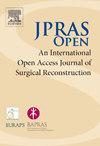Skin subdermal adhesion technique for upper blepharoplasty treatment for dermatochalasis
IF 1.5
Q3 SURGERY
引用次数: 0
Abstract
Aim
We developed a simple bipolar skin and subdermal hemostasis technique called the “Skin Subdermal Adhesion Technique” (SAT), which prevents postoperative complications and provides good cosmetic results.
Patients and Methods
We performed 40 ptosis surgeries in 20 patients using SAT. All patients underwent bilateral excision of the excess skin due to age-related upper eyelid skin laxity; patients with facial nerve palsy and those who underwent manipulation of the levator muscle were excluded. The maximum wound width of the defect after skin resection and diameter after SAT were measured. Additionally, the presence or absence of postoperative complications requiring additional surgeries or procedures was investigated.
Results
The mean (range) age was 76.0 (55–86) years. Among the bilateral resection widths, the diameter of the wider side was 11–20 mm (mean, 14.85±2.67 mm). In contrast, the defect width after SAT was 8–13 mm (mean, 9.75±1.84 mm). SAT reduced the maximum width by 34.3%. There were no cases of postoperative complications, such as wound hematoma formation or infection.
Conclusion
SAT is useful for treating upper eyelid skin defects because it does not require any special equipment, is quick to perform, reduces the risk of postoperative complications such as hematoma, and provides good cosmetic results.
目的我们开发了一种简单的双极皮肤和皮下止血技术,称为 "皮肤皮下粘附技术"(SAT),它可以防止术后并发症,并提供良好的美容效果。患者和方法我们使用 SAT 为 20 名患者实施了 40 例上睑下垂手术。所有患者均接受了双侧上睑皮肤松弛多余皮肤切除术;排除了面神经麻痹患者和接受提上睑肌操作的患者。测量皮肤切除后缺损的最大伤口宽度和 SAT 后的直径。此外,还调查了术后有无需要进行额外手术或程序的并发症。在双侧切除宽度中,较宽一侧的直径为 11-20 毫米(平均为 14.85±2.67 毫米)。相比之下,SAT术后的缺损宽度为8-13毫米(平均为9.75±1.84毫米)。SAT 使最大宽度减少了 34.3%。结论SAT是治疗上眼睑皮肤缺损的有效方法,因为它不需要任何特殊设备,操作快捷,降低了血肿等术后并发症的风险,并提供了良好的美容效果。
本文章由计算机程序翻译,如有差异,请以英文原文为准。
求助全文
约1分钟内获得全文
求助全文
来源期刊

JPRAS Open
Medicine-Surgery
CiteScore
1.60
自引率
0.00%
发文量
89
审稿时长
22 weeks
期刊介绍:
JPRAS Open is an international, open access journal dedicated to publishing case reports, short communications, and full-length articles. JPRAS Open will provide the most current source of information and references in plastic, reconstructive & aesthetic surgery. The Journal is based on the continued need to improve surgical care by providing highlights in general reconstructive surgery; cleft lip, palate and craniofacial surgery; head and neck surgery; skin cancer; breast surgery; hand surgery; lower limb trauma; burns; and aesthetic surgery. The Journal will provide authors with fast publication times.
 求助内容:
求助内容: 应助结果提醒方式:
应助结果提醒方式:


